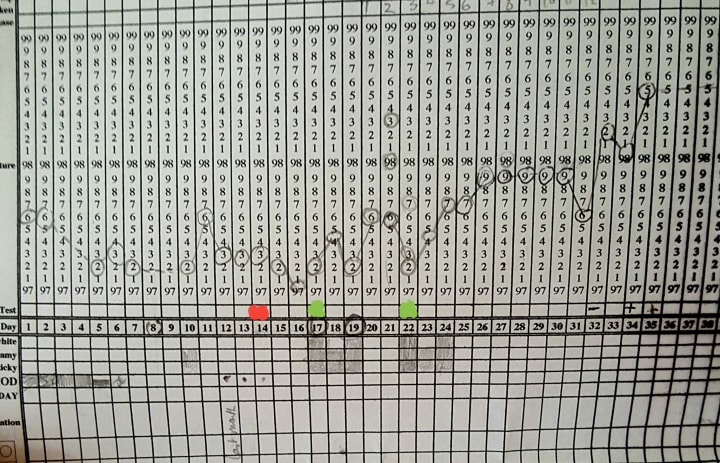Why You Could Be Getting Your Due Date 8 Days Wrong
If I hadn't done this, my birth could have been a whole different story.

What’s in the picture above? It’s a due date wheel.
When you book in for your first pregnancy appointment, they use this wheel to line up your LMP (last menstrual period) to calculate the EDD, the estimated date of delivery—better known as your due date.
What you might not know is that the wheel assumes you ovulated and conceived neatly in the middle of your menstrual cycle—on day 14. When actually, for any woman, it could have been sooner or later.
Wasn't conception the day we had sex?
Your baby won't have necessarily been conceived the day you had sex, because you could've had sex up to five days before it—sperm can live as long as that time! But knowing when you ovulated is to know when you conceived, because an egg will only live for 24 hours—so it will be fertilised within that window.
Some women use ovulation strips or go by body symptoms to know when ovulation is happening, hence knowing when to "do the deed." A more precise way to know is by fertility charting. For anyone unfamiliar, this involves graph-plotting your temperature every morning along with other observations, onto a chart—that women use as a birth control method—as well as to pinpoint exactly when they get pregnant.
Below is my chart for when I got pregnant with my first daughter. Thered dot represents where the due-date wheel would assume I ovulated, on day 14. But this chart helped me learn that I actually ovulated somewhere between the green dots, as late as day 22 (I was also able to learn the sperm lived for four days... which is, well um, fascinating...)!

There's loads of information online about how to do fertility charting, or get the book Taking Charge of Your Fertility
Why is this important?
It means that my prescribed "due date" would've been EIGHT days wrong! Thanks to the knowledge-power of my chart, I was able to calculate my EDD was not 15 April, but 23 April.
As it turned out, my baby came on 21 April. Six days is a lot in late-term-pregnancy-land. Six days that other women would’ve spent worrying about being "overdue," or being gently threatened with talk of induction, when happily in my head, I was two days early!
Now, it must be said that day 22 is a fairly "late" ovulation. But, say if you ovulated on day 15, just 24 hours could still be the difference between an induction and a natural labour. It could be the difference between an easy birth and a hard one. You don't want the stress of being a "post-dates" mother when you aren't even post-dates. Even 40-week pregnant women are pestered with sweeps—which are still a form of induction.
What if I don't know when I ovulated?
All that said, don't worry if you don't know the exact day of your ovulation. In my next pregnancy, I didn't use charting; I went by instinct as to the day of ovulation which this time turned out to be day 14 itself! So, the wheel would have been correct, however, always exert a healthy wariness of the whole due-date concept...
In the US and UK, full-term pregnancy is considered to be 40 weeks. In France, it’s 41, in Kenya it’s 43!
The whole due date thing is culturally arbitrary and much criticised anyway. Take it with a pinch of salt, more a "guess-date" marker. In reality, a woman can give birth anytime from 37-43 weeks: six weeks.
Pressure ever increases on a full-term pregnant woman, prompting coercion into further scans and worry: a suspected large baby; detection of reduced fluid when that can be normal at the end of pregnancy; talk of gestational diabetes, and so on. Any of these may be used to warrant "moving things along" with induction, and the anxiety often overcomes you at the last hurdle. Post-EDD mothers are disturbed in a multitude of ways there isn’t room to describe here.
Of course, sometimes there’s a valid concern for mother or baby at the end of pregnancy, such as pre-eclampsia or infection. But more often, non-problems and cultural obsession with a date wastes the energy we should be harnessing inward as we prepare to give birth. We need also remember the baby is making last crucial developments to its lungs, which signals labour to start. Induction can be risky when not done for a valid reason. Are we really pulling butterflies from their chrysalises by a generalised calculation that baby was conceived up to eight days before they actually were?
Knowledge is power! If you can calculate your "due date" more accurately than your caregiver—do it—and make sure your date goes down as the official one. It could make all the difference!
_____
If you enjoy my articles I would MUCH appreciate you sharing them via Facebook, Instagram, Twitter, or anywhere you'd like. Or fancy giving a tip? All proceeds from clicks and tips go into the making of my next chapter of fine-art series (and passion project) Birth Undisturbed. Thank you... NL
About the Creator
Natalie Lennard
I am a fine-art photographer and mother based in the UK, creating Birth Undisturbed, an award-winning series staging scenes of childbirth. (www.birthundisturbed.com). All proceeds from clicks and tips go toward the next in the series.






Comments
There are no comments for this story
Be the first to respond and start the conversation.